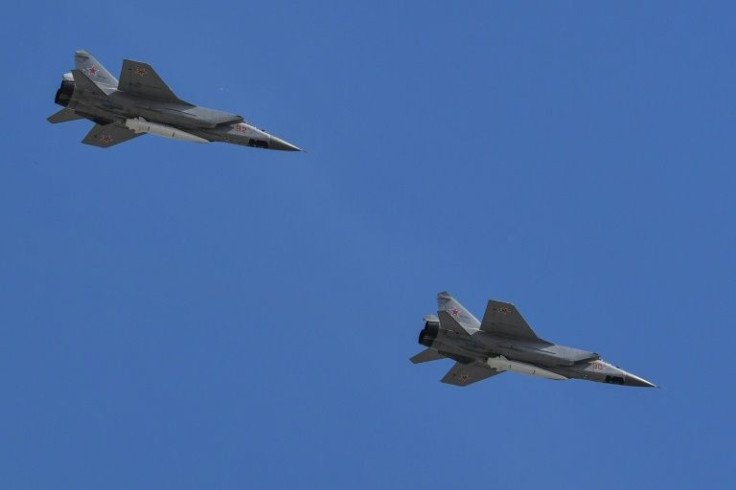US Rushes To Develop Hypersonic Missile With AUKUS After Lagging Behind Russia, China And India

New era of warfare has started with hypersonic missiles and Russia is standing tall with the early bird status by using them for the first time on a battlefield. The U.S., which missed the bus, is making up for the lost time.
China already possesses this missile system that can fly at speeds five times the speed of sound, forcing the trilateral security setup of AUKUS, meant to take on Beijing on the Indo-pacific, to follow suit. According to a report presented in the U.S. Parliament India also has been working on Hypersonic missiles and has already tested them a couple of times.
Surprisingly, the U.S., the world's largest defence spender, was caught napping and the Biden administration is currently leaving no stones unturned to make up for the delay.
At the time of the unveiling cutting-edge missile system earlier last month, Putin claimed the Kinzhal missile as an "ideal weapon" to thwart U.S. plans.
Its military said that the Kinzhal system is capable of flying 27 times faster than the speed of sound and can make sharp maneuvers. It has been fitted with Soviet-built intercontinental ballistic missiles.
"Russia still has the greatest nuclear potential in the world, but nobody listened to us," said Putin. "Listen now."
Putin's statement was not well received by the U.S. government. U.S. State Department spokeswoman Heather Nauert said: "That's certainly something that we did not enjoy watching, we don't regard that as the behavior of a responsible international player."
U.S. Defense Secretary James Mattis was also not convinced by the claims Mattis, en-route to Oman, told reporters the technology is "still years away."
"At the end of the day, they can sink all that money in; it does not change my strategic calculation," jumping into conclusion Mattis said.
Seizing the Ukraine invasion as the right place to stage its debut with hypersonic missiles, the Russian defence ministry used Kh-47M2 Kinzhal hypersonic missiles to inflict damage on an ammunition warehouse in western Ukraine.
Initially, the U.S. administration was sulking believing the Russian claims and snubbed them. Putting all speculations to rest, US President Joe Biden March 21 confirmed the Russian defense ministry's claim that hypersonic missiles were used in Ukraine.
Recently, a congressional research report found that China and Russia have both developed hypersonic missiles that can carry nuclear weapons. The report presented in the U.S. Parliament, also said that Indian Hypersonic missiles will be capable of firing nuclear weapons along with conventional weapons.
China's rapid progress with hypersonic weapons has caused alarm in Washington. Last year, the Pentagon said a Chinese hypersonic missile test flight had circled the planet before crashing inside the country.
In October, Gen. Mark Milley, chairman of the Joint Chiefs of Staff, confirmed that China conducted a test of a hypersonic weapon system. Last July, China had tested its intercontinental hypersonic glide vehicle that can reach the U.S. mainland.
In an apparent response to China's pursuit of its own hypersonic arsenal, in a signed joint statement by Biden, British Prime Minister Boris Johnson and Australian Prime Minister Scott Morrison, the three leaders said they would cooperate on "hypersonics and counter-hypersonics, and electronic warfare capabilities."
They will work together through the security alliance known as AUKUS to develop hypersonic missiles.
Citing Chinese naval presence 1,200 miles off the northeast Australian coast in the Solomon Islands, Morrison said the hypersonic missiles fit into Australia's strategic plan to enhance its military's long-range strike capabilities.
The AUKUS said the move comes in the "light of Russia's unprovoked, unjustified, and unlawful invasion of Ukraine..."
When the US tried to experiment with hypersonic missile, The Lockheed Martin missile failed three consecutive booster motor tests last year, which cause a slower pace of U.S. hypersonic programs. Lockheed bagged an initial $480 million contract in April 2018 which was broadened in December 2019 to $986 million.
The U.S. is lagging behind China, India and Russia. The U.S. no longer dominates in several advanced technologies, an influential American Senator observed, saying that India, Russia, and China have advantages on hypersonic technology.
When it comes to hypersonic, China, India, and Russia have advantages, Senator Jack Reed, Chairman of the Senate Armed Services Committee, said during a nomination hearing March 23.
This has resulted in a trilateral nuclear competition involving China, Russia, and the United States," Senator Reed added
.
To match China and Russia in possessing this cutting-edge strategic weapon, the U.S. military announced April 5 a new test of a hypersonic missile.
The Defense Advanced Research Projects Agency (DARPA), the Pentagon's high-tech research agency, said it completed a free-flight test of an aircraft-launched hypersonic missile.
The missile flew to an altitude above 65,000 feet and soared over 300 nautical miles, DARPA said.
According to CNN, the test took place in mid-March, but the administration was tight-lipped about it due to geopolitical tensions in Eastern Europe over the Russian invasion of Ukraine.
The Pentagon's 2023 budget includes $4.7 billion for the research and development of hypersonic weapons. It plans to put in place a hypersonic missile battery fielded by next year, a sea-based missile by 2025, and after two years an air-based cruise missile.
Hypersonic missiles pose threats to the global military balance as they can precisely deliver nuclear weapons on target, at speeds too fast to intercept.
No wonder why the U.S. is mending its ways at a high speed.
























